Sustainable Tourism Development: Planning, Implementation, and Impact
VerifiedAdded on 2020/06/03
|21
|6237
|109
Report
AI Summary
This report provides a detailed analysis of sustainable tourism development, focusing on the Philippines. It begins with an introduction highlighting the importance of tourism for economic and social development. Task 1 explores the benefits of tourism development planning, including resource availability, economic growth, and cultural preservation, and discusses the advantages and disadvantages of public-private partnerships. Task 2 delves into the different levels of tourism planning—international, national, regional, and sub-regional—and emphasizes the importance of interactive planning. It also evaluates various methods for measuring tourism's impact, including economic, environmental, and social measures. The report further includes justification for introducing sustainable concepts in poster format, analyzes factors hindering sustainable tourism, and evaluates methods for resolving conflicts of interest and ethical issues in enclave tourism. It concludes with a comparison of current issues in tourism development, recommendations for future development, and a comprehensive reference list.
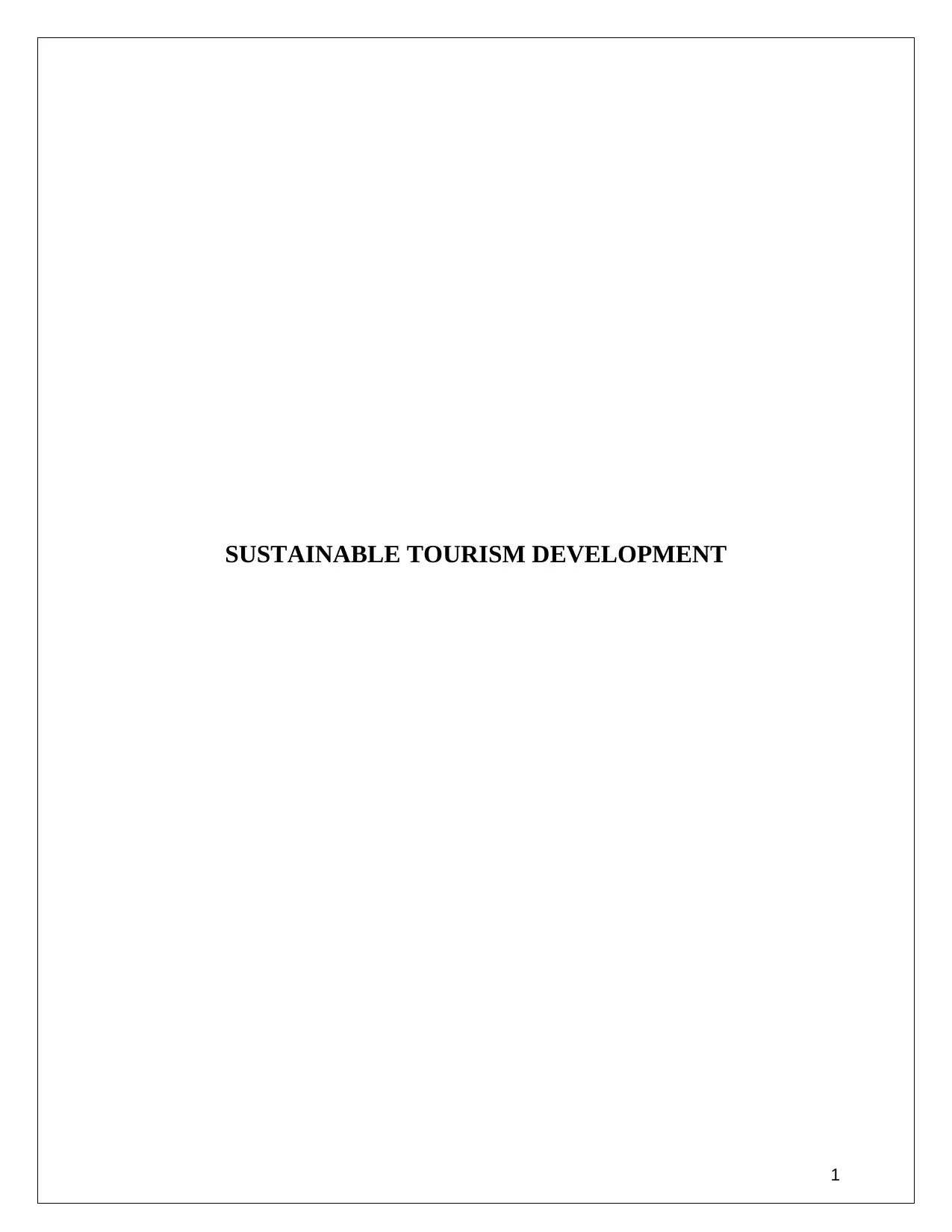
SUSTAINABLE TOURISM DEVELOPMENT
1
1
Paraphrase This Document
Need a fresh take? Get an instant paraphrase of this document with our AI Paraphraser
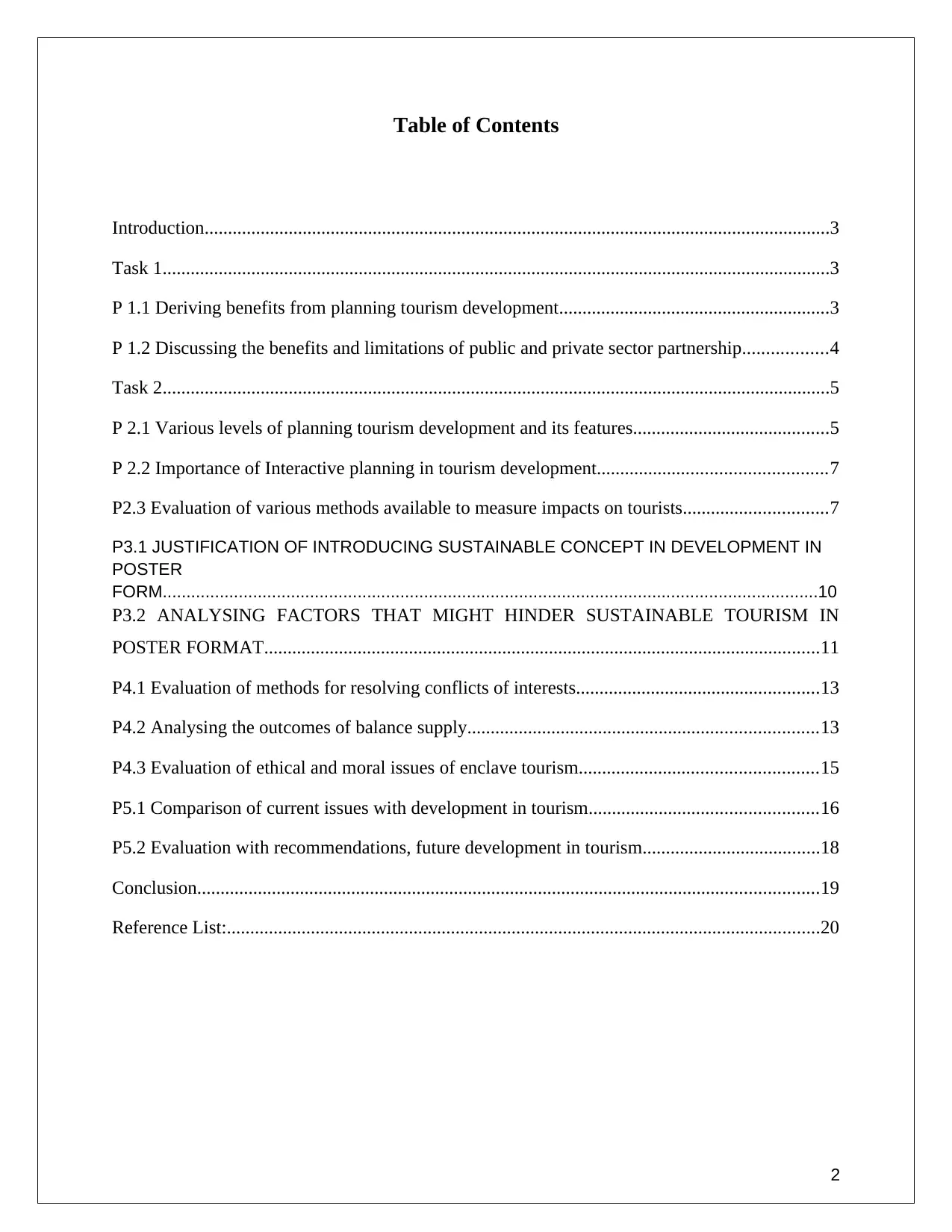
Table of Contents
Introduction......................................................................................................................................3
Task 1...............................................................................................................................................3
P 1.1 Deriving benefits from planning tourism development..........................................................3
P 1.2 Discussing the benefits and limitations of public and private sector partnership..................4
Task 2...............................................................................................................................................5
P 2.1 Various levels of planning tourism development and its features..........................................5
P 2.2 Importance of Interactive planning in tourism development.................................................7
P2.3 Evaluation of various methods available to measure impacts on tourists...............................7
P3.1 JUSTIFICATION OF INTRODUCING SUSTAINABLE CONCEPT IN DEVELOPMENT IN
POSTER
FORM..........................................................................................................................................10
P3.2 ANALYSING FACTORS THAT MIGHT HINDER SUSTAINABLE TOURISM IN
POSTER FORMAT.......................................................................................................................11
P4.1 Evaluation of methods for resolving conflicts of interests....................................................13
P4.2 Analysing the outcomes of balance supply...........................................................................13
P4.3 Evaluation of ethical and moral issues of enclave tourism...................................................15
P5.1 Comparison of current issues with development in tourism.................................................16
P5.2 Evaluation with recommendations, future development in tourism......................................18
Conclusion.....................................................................................................................................19
Reference List:...............................................................................................................................20
2
Introduction......................................................................................................................................3
Task 1...............................................................................................................................................3
P 1.1 Deriving benefits from planning tourism development..........................................................3
P 1.2 Discussing the benefits and limitations of public and private sector partnership..................4
Task 2...............................................................................................................................................5
P 2.1 Various levels of planning tourism development and its features..........................................5
P 2.2 Importance of Interactive planning in tourism development.................................................7
P2.3 Evaluation of various methods available to measure impacts on tourists...............................7
P3.1 JUSTIFICATION OF INTRODUCING SUSTAINABLE CONCEPT IN DEVELOPMENT IN
POSTER
FORM..........................................................................................................................................10
P3.2 ANALYSING FACTORS THAT MIGHT HINDER SUSTAINABLE TOURISM IN
POSTER FORMAT.......................................................................................................................11
P4.1 Evaluation of methods for resolving conflicts of interests....................................................13
P4.2 Analysing the outcomes of balance supply...........................................................................13
P4.3 Evaluation of ethical and moral issues of enclave tourism...................................................15
P5.1 Comparison of current issues with development in tourism.................................................16
P5.2 Evaluation with recommendations, future development in tourism......................................18
Conclusion.....................................................................................................................................19
Reference List:...............................................................................................................................20
2
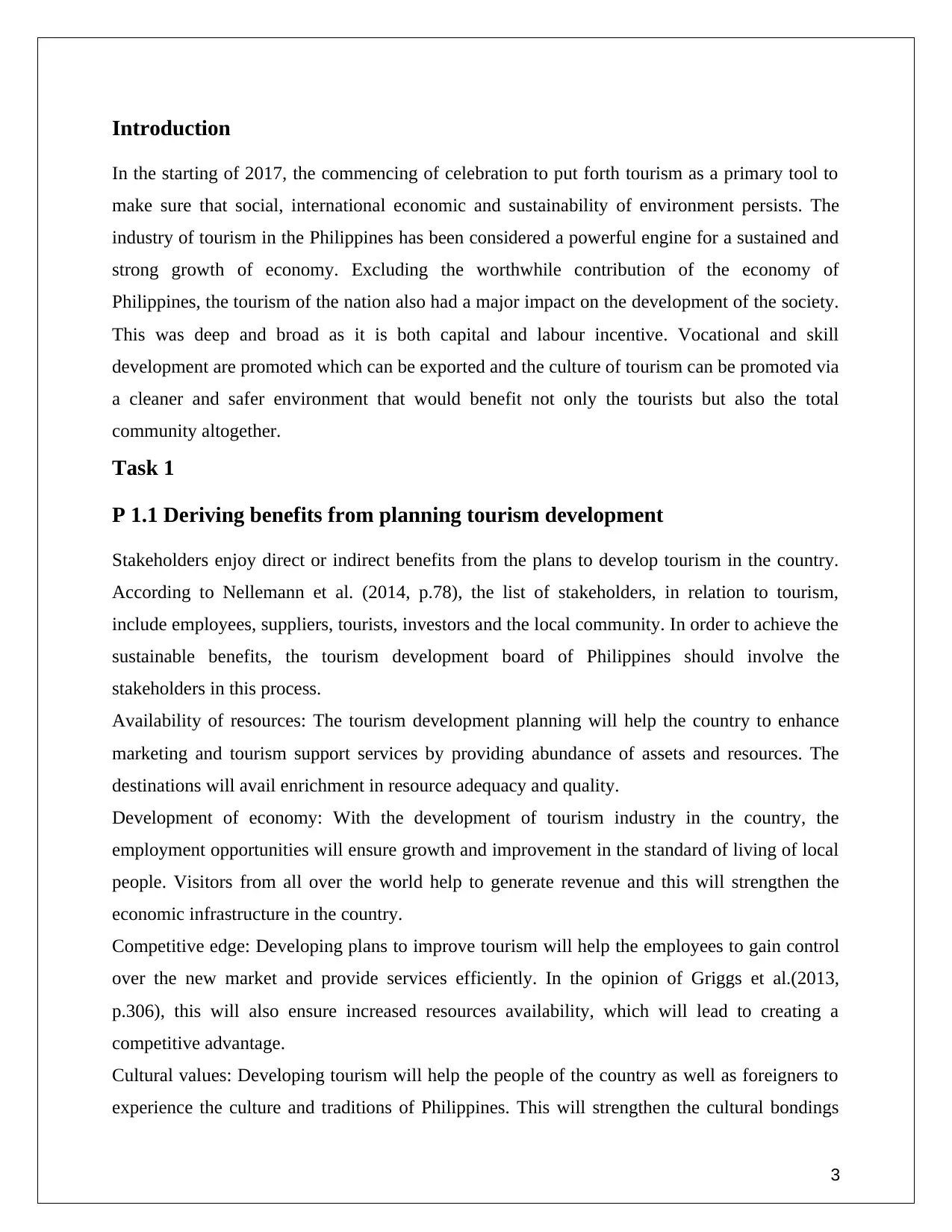
Introduction
In the starting of 2017, the commencing of celebration to put forth tourism as a primary tool to
make sure that social, international economic and sustainability of environment persists. The
industry of tourism in the Philippines has been considered a powerful engine for a sustained and
strong growth of economy. Excluding the worthwhile contribution of the economy of
Philippines, the tourism of the nation also had a major impact on the development of the society.
This was deep and broad as it is both capital and labour incentive. Vocational and skill
development are promoted which can be exported and the culture of tourism can be promoted via
a cleaner and safer environment that would benefit not only the tourists but also the total
community altogether.
Task 1
P 1.1 Deriving benefits from planning tourism development
Stakeholders enjoy direct or indirect benefits from the plans to develop tourism in the country.
According to Nellemann et al. (2014, p.78), the list of stakeholders, in relation to tourism,
include employees, suppliers, tourists, investors and the local community. In order to achieve the
sustainable benefits, the tourism development board of Philippines should involve the
stakeholders in this process.
Availability of resources: The tourism development planning will help the country to enhance
marketing and tourism support services by providing abundance of assets and resources. The
destinations will avail enrichment in resource adequacy and quality.
Development of economy: With the development of tourism industry in the country, the
employment opportunities will ensure growth and improvement in the standard of living of local
people. Visitors from all over the world help to generate revenue and this will strengthen the
economic infrastructure in the country.
Competitive edge: Developing plans to improve tourism will help the employees to gain control
over the new market and provide services efficiently. In the opinion of Griggs et al.(2013,
p.306), this will also ensure increased resources availability, which will lead to creating a
competitive advantage.
Cultural values: Developing tourism will help the people of the country as well as foreigners to
experience the culture and traditions of Philippines. This will strengthen the cultural bondings
3
In the starting of 2017, the commencing of celebration to put forth tourism as a primary tool to
make sure that social, international economic and sustainability of environment persists. The
industry of tourism in the Philippines has been considered a powerful engine for a sustained and
strong growth of economy. Excluding the worthwhile contribution of the economy of
Philippines, the tourism of the nation also had a major impact on the development of the society.
This was deep and broad as it is both capital and labour incentive. Vocational and skill
development are promoted which can be exported and the culture of tourism can be promoted via
a cleaner and safer environment that would benefit not only the tourists but also the total
community altogether.
Task 1
P 1.1 Deriving benefits from planning tourism development
Stakeholders enjoy direct or indirect benefits from the plans to develop tourism in the country.
According to Nellemann et al. (2014, p.78), the list of stakeholders, in relation to tourism,
include employees, suppliers, tourists, investors and the local community. In order to achieve the
sustainable benefits, the tourism development board of Philippines should involve the
stakeholders in this process.
Availability of resources: The tourism development planning will help the country to enhance
marketing and tourism support services by providing abundance of assets and resources. The
destinations will avail enrichment in resource adequacy and quality.
Development of economy: With the development of tourism industry in the country, the
employment opportunities will ensure growth and improvement in the standard of living of local
people. Visitors from all over the world help to generate revenue and this will strengthen the
economic infrastructure in the country.
Competitive edge: Developing plans to improve tourism will help the employees to gain control
over the new market and provide services efficiently. In the opinion of Griggs et al.(2013,
p.306), this will also ensure increased resources availability, which will lead to creating a
competitive advantage.
Cultural values: Developing tourism will help the people of the country as well as foreigners to
experience the culture and traditions of Philippines. This will strengthen the cultural bondings
3
⊘ This is a preview!⊘
Do you want full access?
Subscribe today to unlock all pages.

Trusted by 1+ million students worldwide
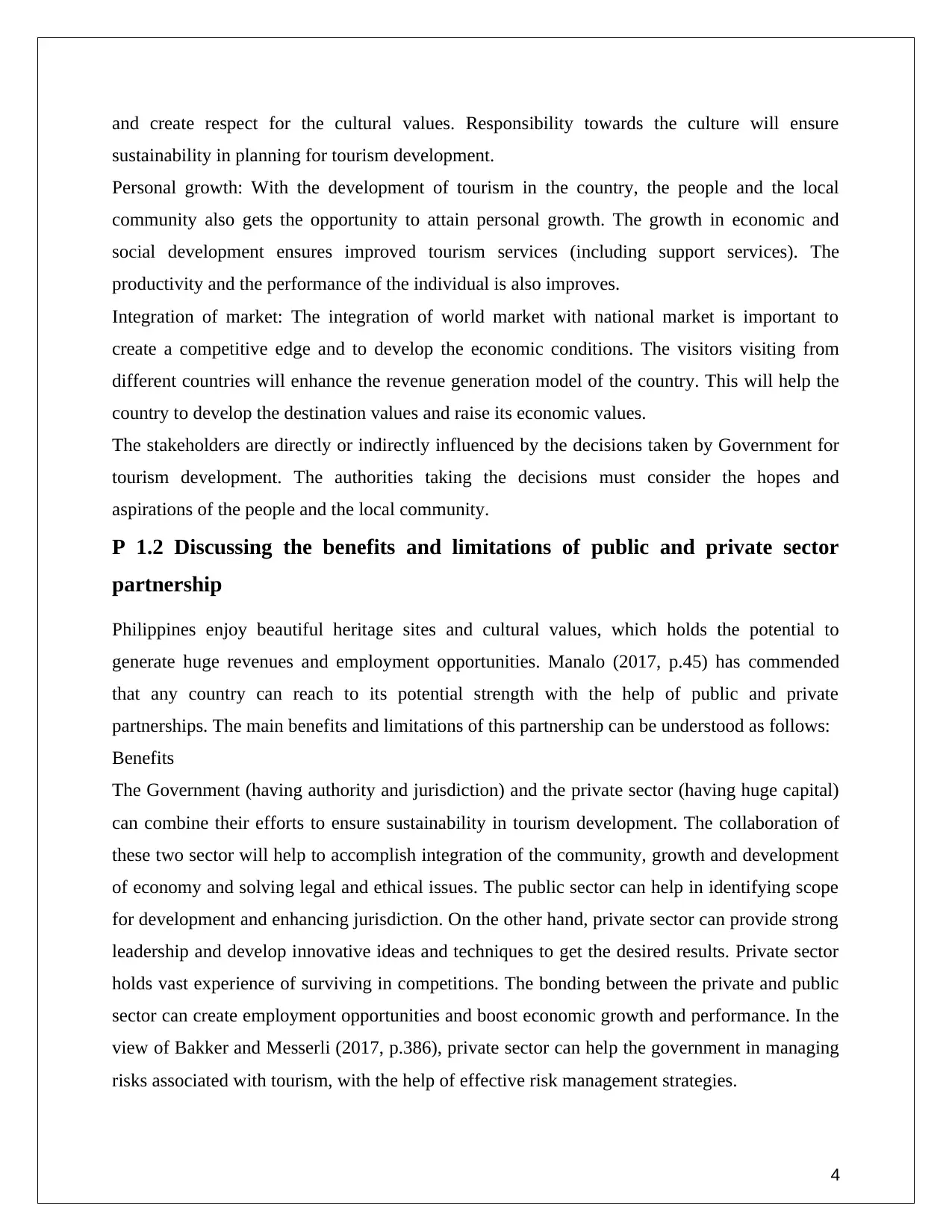
and create respect for the cultural values. Responsibility towards the culture will ensure
sustainability in planning for tourism development.
Personal growth: With the development of tourism in the country, the people and the local
community also gets the opportunity to attain personal growth. The growth in economic and
social development ensures improved tourism services (including support services). The
productivity and the performance of the individual is also improves.
Integration of market: The integration of world market with national market is important to
create a competitive edge and to develop the economic conditions. The visitors visiting from
different countries will enhance the revenue generation model of the country. This will help the
country to develop the destination values and raise its economic values.
The stakeholders are directly or indirectly influenced by the decisions taken by Government for
tourism development. The authorities taking the decisions must consider the hopes and
aspirations of the people and the local community.
P 1.2 Discussing the benefits and limitations of public and private sector
partnership
Philippines enjoy beautiful heritage sites and cultural values, which holds the potential to
generate huge revenues and employment opportunities. Manalo (2017, p.45) has commended
that any country can reach to its potential strength with the help of public and private
partnerships. The main benefits and limitations of this partnership can be understood as follows:
Benefits
The Government (having authority and jurisdiction) and the private sector (having huge capital)
can combine their efforts to ensure sustainability in tourism development. The collaboration of
these two sector will help to accomplish integration of the community, growth and development
of economy and solving legal and ethical issues. The public sector can help in identifying scope
for development and enhancing jurisdiction. On the other hand, private sector can provide strong
leadership and develop innovative ideas and techniques to get the desired results. Private sector
holds vast experience of surviving in competitions. The bonding between the private and public
sector can create employment opportunities and boost economic growth and performance. In the
view of Bakker and Messerli (2017, p.386), private sector can help the government in managing
risks associated with tourism, with the help of effective risk management strategies.
4
sustainability in planning for tourism development.
Personal growth: With the development of tourism in the country, the people and the local
community also gets the opportunity to attain personal growth. The growth in economic and
social development ensures improved tourism services (including support services). The
productivity and the performance of the individual is also improves.
Integration of market: The integration of world market with national market is important to
create a competitive edge and to develop the economic conditions. The visitors visiting from
different countries will enhance the revenue generation model of the country. This will help the
country to develop the destination values and raise its economic values.
The stakeholders are directly or indirectly influenced by the decisions taken by Government for
tourism development. The authorities taking the decisions must consider the hopes and
aspirations of the people and the local community.
P 1.2 Discussing the benefits and limitations of public and private sector
partnership
Philippines enjoy beautiful heritage sites and cultural values, which holds the potential to
generate huge revenues and employment opportunities. Manalo (2017, p.45) has commended
that any country can reach to its potential strength with the help of public and private
partnerships. The main benefits and limitations of this partnership can be understood as follows:
Benefits
The Government (having authority and jurisdiction) and the private sector (having huge capital)
can combine their efforts to ensure sustainability in tourism development. The collaboration of
these two sector will help to accomplish integration of the community, growth and development
of economy and solving legal and ethical issues. The public sector can help in identifying scope
for development and enhancing jurisdiction. On the other hand, private sector can provide strong
leadership and develop innovative ideas and techniques to get the desired results. Private sector
holds vast experience of surviving in competitions. The bonding between the private and public
sector can create employment opportunities and boost economic growth and performance. In the
view of Bakker and Messerli (2017, p.386), private sector can help the government in managing
risks associated with tourism, with the help of effective risk management strategies.
4
Paraphrase This Document
Need a fresh take? Get an instant paraphrase of this document with our AI Paraphraser
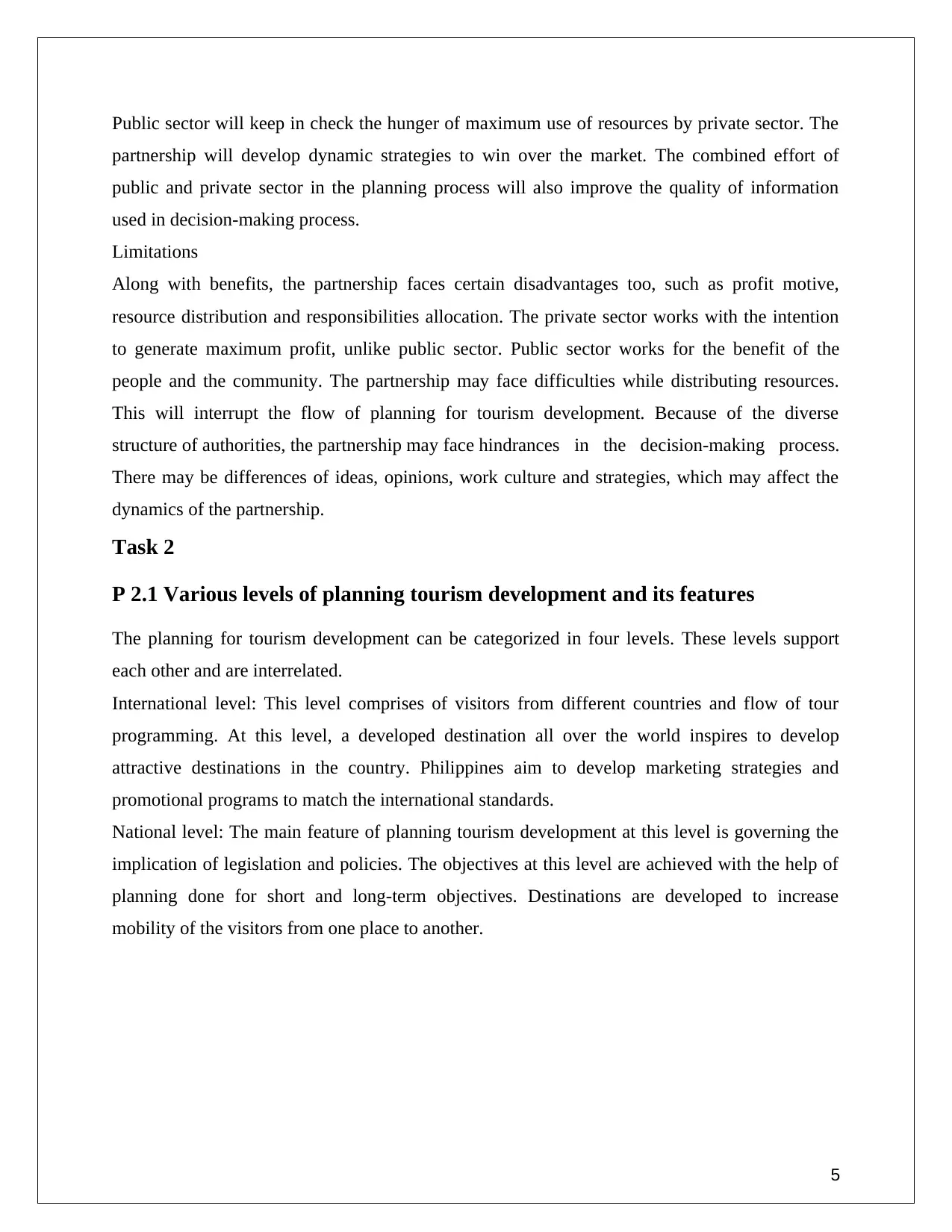
Public sector will keep in check the hunger of maximum use of resources by private sector. The
partnership will develop dynamic strategies to win over the market. The combined effort of
public and private sector in the planning process will also improve the quality of information
used in decision-making process.
Limitations
Along with benefits, the partnership faces certain disadvantages too, such as profit motive,
resource distribution and responsibilities allocation. The private sector works with the intention
to generate maximum profit, unlike public sector. Public sector works for the benefit of the
people and the community. The partnership may face difficulties while distributing resources.
This will interrupt the flow of planning for tourism development. Because of the diverse
structure of authorities, the partnership may face hindrances in the decision-making process.
There may be differences of ideas, opinions, work culture and strategies, which may affect the
dynamics of the partnership.
Task 2
P 2.1 Various levels of planning tourism development and its features
The planning for tourism development can be categorized in four levels. These levels support
each other and are interrelated.
International level: This level comprises of visitors from different countries and flow of tour
programming. At this level, a developed destination all over the world inspires to develop
attractive destinations in the country. Philippines aim to develop marketing strategies and
promotional programs to match the international standards.
National level: The main feature of planning tourism development at this level is governing the
implication of legislation and policies. The objectives at this level are achieved with the help of
planning done for short and long-term objectives. Destinations are developed to increase
mobility of the visitors from one place to another.
5
partnership will develop dynamic strategies to win over the market. The combined effort of
public and private sector in the planning process will also improve the quality of information
used in decision-making process.
Limitations
Along with benefits, the partnership faces certain disadvantages too, such as profit motive,
resource distribution and responsibilities allocation. The private sector works with the intention
to generate maximum profit, unlike public sector. Public sector works for the benefit of the
people and the community. The partnership may face difficulties while distributing resources.
This will interrupt the flow of planning for tourism development. Because of the diverse
structure of authorities, the partnership may face hindrances in the decision-making process.
There may be differences of ideas, opinions, work culture and strategies, which may affect the
dynamics of the partnership.
Task 2
P 2.1 Various levels of planning tourism development and its features
The planning for tourism development can be categorized in four levels. These levels support
each other and are interrelated.
International level: This level comprises of visitors from different countries and flow of tour
programming. At this level, a developed destination all over the world inspires to develop
attractive destinations in the country. Philippines aim to develop marketing strategies and
promotional programs to match the international standards.
National level: The main feature of planning tourism development at this level is governing the
implication of legislation and policies. The objectives at this level are achieved with the help of
planning done for short and long-term objectives. Destinations are developed to increase
mobility of the visitors from one place to another.
5
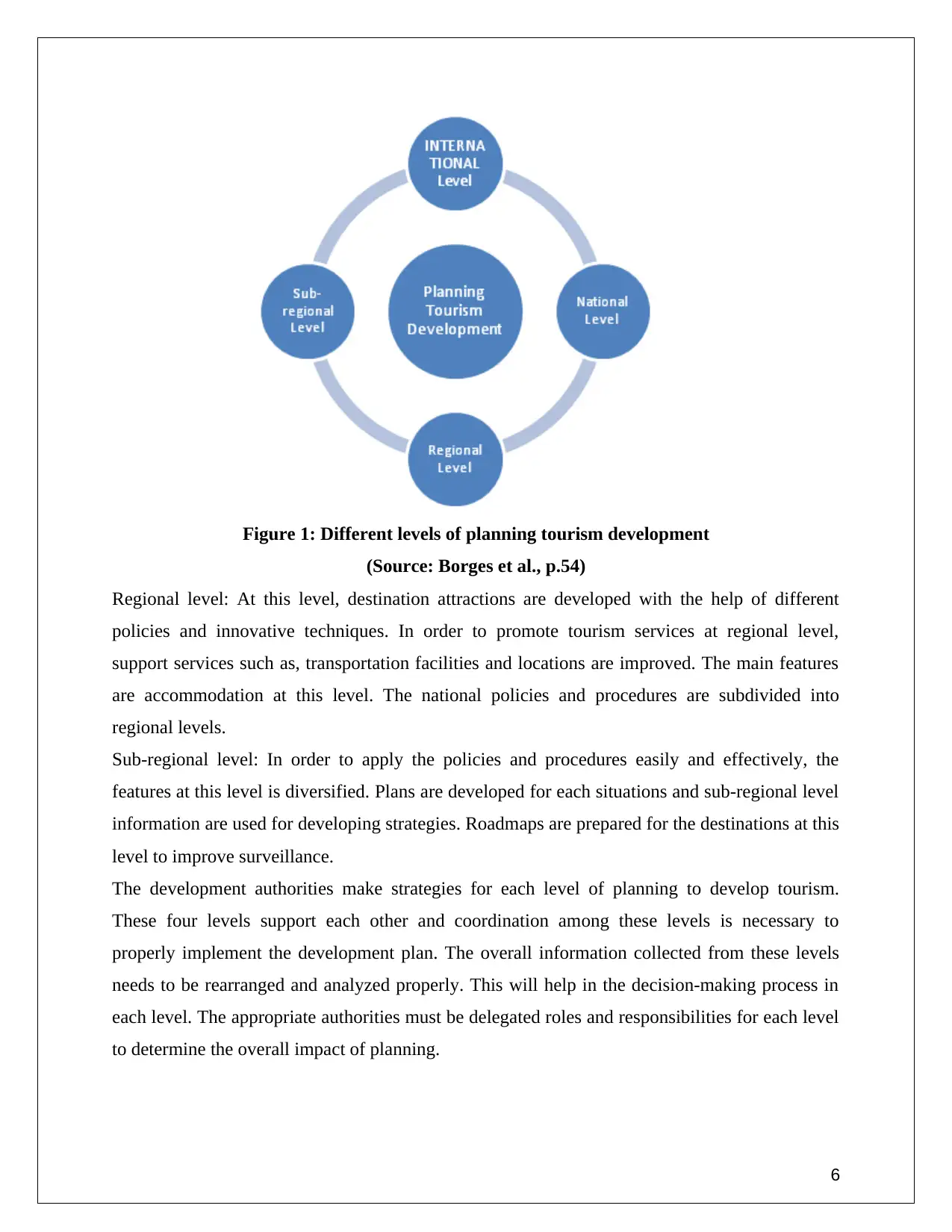
Figure 1: Different levels of planning tourism development
(Source: Borges et al., p.54)
Regional level: At this level, destination attractions are developed with the help of different
policies and innovative techniques. In order to promote tourism services at regional level,
support services such as, transportation facilities and locations are improved. The main features
are accommodation at this level. The national policies and procedures are subdivided into
regional levels.
Sub-regional level: In order to apply the policies and procedures easily and effectively, the
features at this level is diversified. Plans are developed for each situations and sub-regional level
information are used for developing strategies. Roadmaps are prepared for the destinations at this
level to improve surveillance.
The development authorities make strategies for each level of planning to develop tourism.
These four levels support each other and coordination among these levels is necessary to
properly implement the development plan. The overall information collected from these levels
needs to be rearranged and analyzed properly. This will help in the decision-making process in
each level. The appropriate authorities must be delegated roles and responsibilities for each level
to determine the overall impact of planning.
6
(Source: Borges et al., p.54)
Regional level: At this level, destination attractions are developed with the help of different
policies and innovative techniques. In order to promote tourism services at regional level,
support services such as, transportation facilities and locations are improved. The main features
are accommodation at this level. The national policies and procedures are subdivided into
regional levels.
Sub-regional level: In order to apply the policies and procedures easily and effectively, the
features at this level is diversified. Plans are developed for each situations and sub-regional level
information are used for developing strategies. Roadmaps are prepared for the destinations at this
level to improve surveillance.
The development authorities make strategies for each level of planning to develop tourism.
These four levels support each other and coordination among these levels is necessary to
properly implement the development plan. The overall information collected from these levels
needs to be rearranged and analyzed properly. This will help in the decision-making process in
each level. The appropriate authorities must be delegated roles and responsibilities for each level
to determine the overall impact of planning.
6
⊘ This is a preview!⊘
Do you want full access?
Subscribe today to unlock all pages.

Trusted by 1+ million students worldwide
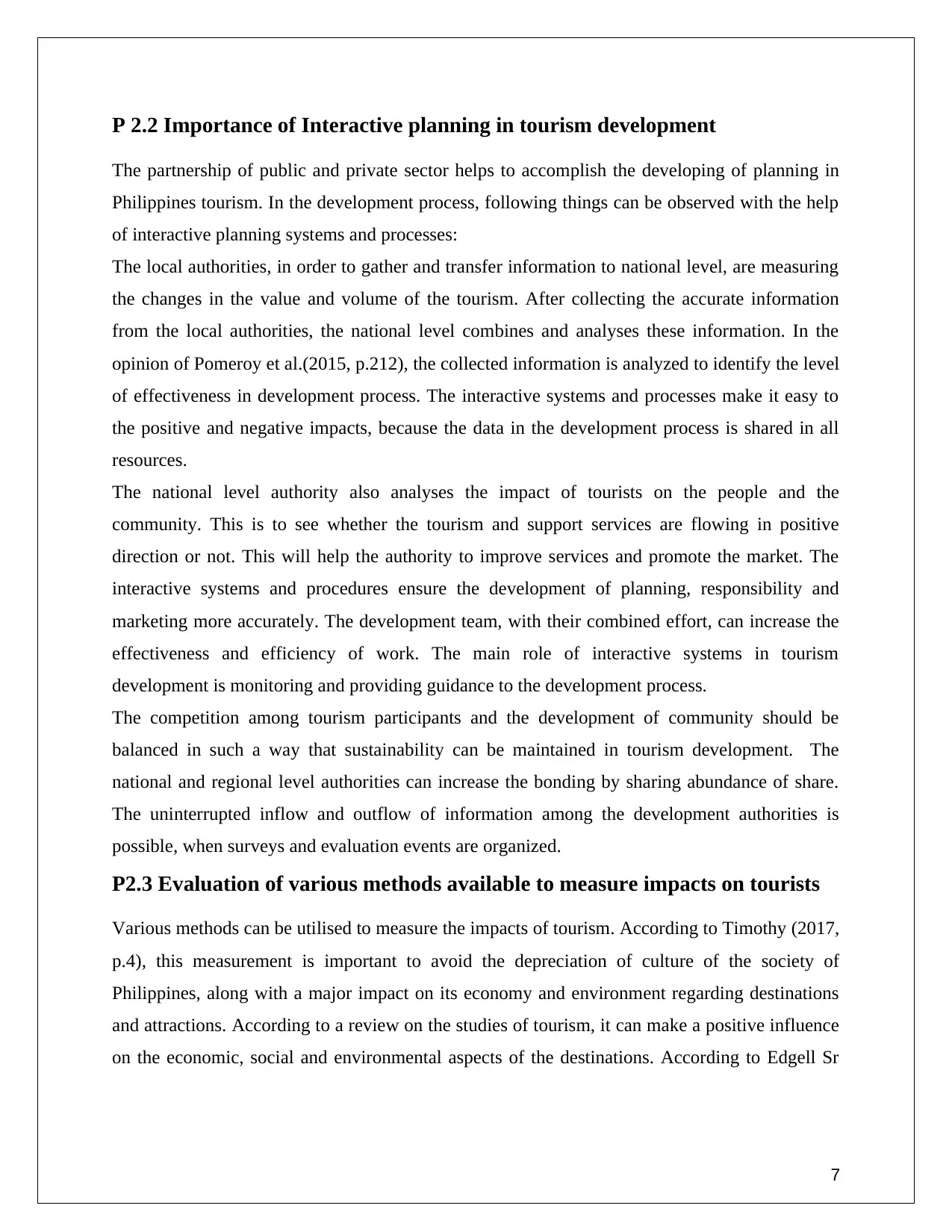
P 2.2 Importance of Interactive planning in tourism development
The partnership of public and private sector helps to accomplish the developing of planning in
Philippines tourism. In the development process, following things can be observed with the help
of interactive planning systems and processes:
The local authorities, in order to gather and transfer information to national level, are measuring
the changes in the value and volume of the tourism. After collecting the accurate information
from the local authorities, the national level combines and analyses these information. In the
opinion of Pomeroy et al.(2015, p.212), the collected information is analyzed to identify the level
of effectiveness in development process. The interactive systems and processes make it easy to
the positive and negative impacts, because the data in the development process is shared in all
resources.
The national level authority also analyses the impact of tourists on the people and the
community. This is to see whether the tourism and support services are flowing in positive
direction or not. This will help the authority to improve services and promote the market. The
interactive systems and procedures ensure the development of planning, responsibility and
marketing more accurately. The development team, with their combined effort, can increase the
effectiveness and efficiency of work. The main role of interactive systems in tourism
development is monitoring and providing guidance to the development process.
The competition among tourism participants and the development of community should be
balanced in such a way that sustainability can be maintained in tourism development. The
national and regional level authorities can increase the bonding by sharing abundance of share.
The uninterrupted inflow and outflow of information among the development authorities is
possible, when surveys and evaluation events are organized.
P2.3 Evaluation of various methods available to measure impacts on tourists
Various methods can be utilised to measure the impacts of tourism. According to Timothy (2017,
p.4), this measurement is important to avoid the depreciation of culture of the society of
Philippines, along with a major impact on its economy and environment regarding destinations
and attractions. According to a review on the studies of tourism, it can make a positive influence
on the economic, social and environmental aspects of the destinations. According to Edgell Sr
7
The partnership of public and private sector helps to accomplish the developing of planning in
Philippines tourism. In the development process, following things can be observed with the help
of interactive planning systems and processes:
The local authorities, in order to gather and transfer information to national level, are measuring
the changes in the value and volume of the tourism. After collecting the accurate information
from the local authorities, the national level combines and analyses these information. In the
opinion of Pomeroy et al.(2015, p.212), the collected information is analyzed to identify the level
of effectiveness in development process. The interactive systems and processes make it easy to
the positive and negative impacts, because the data in the development process is shared in all
resources.
The national level authority also analyses the impact of tourists on the people and the
community. This is to see whether the tourism and support services are flowing in positive
direction or not. This will help the authority to improve services and promote the market. The
interactive systems and procedures ensure the development of planning, responsibility and
marketing more accurately. The development team, with their combined effort, can increase the
effectiveness and efficiency of work. The main role of interactive systems in tourism
development is monitoring and providing guidance to the development process.
The competition among tourism participants and the development of community should be
balanced in such a way that sustainability can be maintained in tourism development. The
national and regional level authorities can increase the bonding by sharing abundance of share.
The uninterrupted inflow and outflow of information among the development authorities is
possible, when surveys and evaluation events are organized.
P2.3 Evaluation of various methods available to measure impacts on tourists
Various methods can be utilised to measure the impacts of tourism. According to Timothy (2017,
p.4), this measurement is important to avoid the depreciation of culture of the society of
Philippines, along with a major impact on its economy and environment regarding destinations
and attractions. According to a review on the studies of tourism, it can make a positive influence
on the economic, social and environmental aspects of the destinations. According to Edgell Sr
7
Paraphrase This Document
Need a fresh take? Get an instant paraphrase of this document with our AI Paraphraser
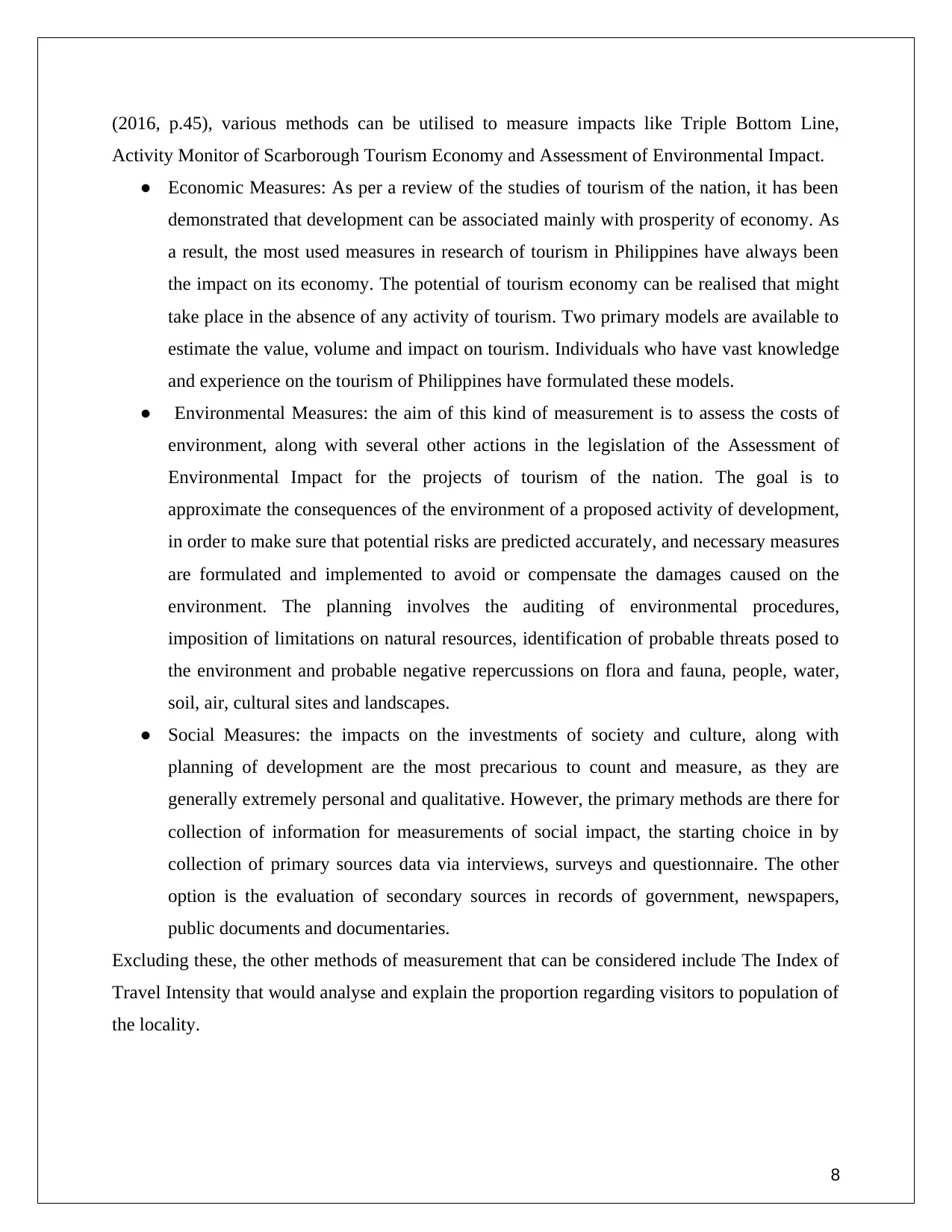
(2016, p.45), various methods can be utilised to measure impacts like Triple Bottom Line,
Activity Monitor of Scarborough Tourism Economy and Assessment of Environmental Impact.
● Economic Measures: As per a review of the studies of tourism of the nation, it has been
demonstrated that development can be associated mainly with prosperity of economy. As
a result, the most used measures in research of tourism in Philippines have always been
the impact on its economy. The potential of tourism economy can be realised that might
take place in the absence of any activity of tourism. Two primary models are available to
estimate the value, volume and impact on tourism. Individuals who have vast knowledge
and experience on the tourism of Philippines have formulated these models.
● Environmental Measures: the aim of this kind of measurement is to assess the costs of
environment, along with several other actions in the legislation of the Assessment of
Environmental Impact for the projects of tourism of the nation. The goal is to
approximate the consequences of the environment of a proposed activity of development,
in order to make sure that potential risks are predicted accurately, and necessary measures
are formulated and implemented to avoid or compensate the damages caused on the
environment. The planning involves the auditing of environmental procedures,
imposition of limitations on natural resources, identification of probable threats posed to
the environment and probable negative repercussions on flora and fauna, people, water,
soil, air, cultural sites and landscapes.
● Social Measures: the impacts on the investments of society and culture, along with
planning of development are the most precarious to count and measure, as they are
generally extremely personal and qualitative. However, the primary methods are there for
collection of information for measurements of social impact, the starting choice in by
collection of primary sources data via interviews, surveys and questionnaire. The other
option is the evaluation of secondary sources in records of government, newspapers,
public documents and documentaries.
Excluding these, the other methods of measurement that can be considered include The Index of
Travel Intensity that would analyse and explain the proportion regarding visitors to population of
the locality.
8
Activity Monitor of Scarborough Tourism Economy and Assessment of Environmental Impact.
● Economic Measures: As per a review of the studies of tourism of the nation, it has been
demonstrated that development can be associated mainly with prosperity of economy. As
a result, the most used measures in research of tourism in Philippines have always been
the impact on its economy. The potential of tourism economy can be realised that might
take place in the absence of any activity of tourism. Two primary models are available to
estimate the value, volume and impact on tourism. Individuals who have vast knowledge
and experience on the tourism of Philippines have formulated these models.
● Environmental Measures: the aim of this kind of measurement is to assess the costs of
environment, along with several other actions in the legislation of the Assessment of
Environmental Impact for the projects of tourism of the nation. The goal is to
approximate the consequences of the environment of a proposed activity of development,
in order to make sure that potential risks are predicted accurately, and necessary measures
are formulated and implemented to avoid or compensate the damages caused on the
environment. The planning involves the auditing of environmental procedures,
imposition of limitations on natural resources, identification of probable threats posed to
the environment and probable negative repercussions on flora and fauna, people, water,
soil, air, cultural sites and landscapes.
● Social Measures: the impacts on the investments of society and culture, along with
planning of development are the most precarious to count and measure, as they are
generally extremely personal and qualitative. However, the primary methods are there for
collection of information for measurements of social impact, the starting choice in by
collection of primary sources data via interviews, surveys and questionnaire. The other
option is the evaluation of secondary sources in records of government, newspapers,
public documents and documentaries.
Excluding these, the other methods of measurement that can be considered include The Index of
Travel Intensity that would analyse and explain the proportion regarding visitors to population of
the locality.
8
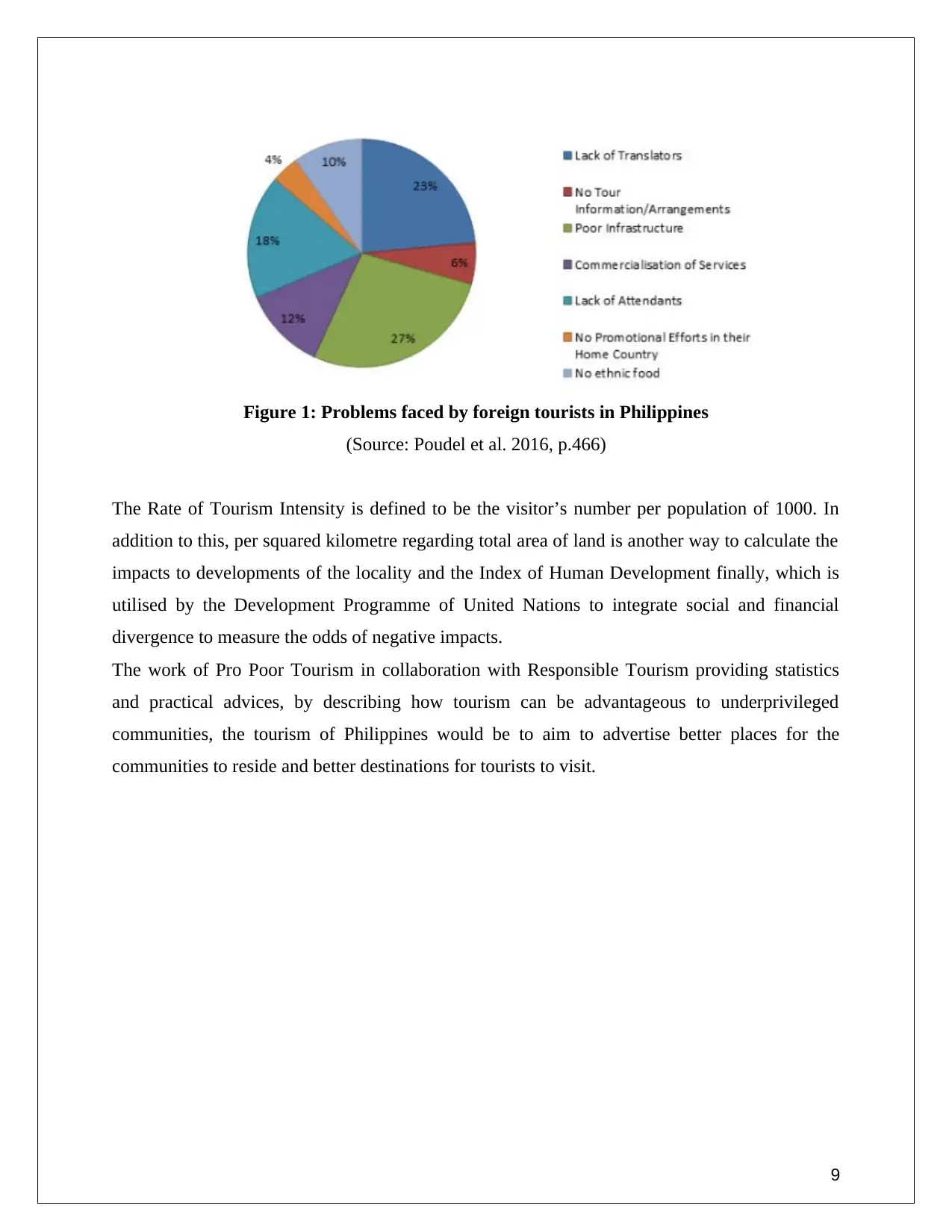
Figure 1: Problems faced by foreign tourists in Philippines
(Source: Poudel et al. 2016, p.466)
The Rate of Tourism Intensity is defined to be the visitor’s number per population of 1000. In
addition to this, per squared kilometre regarding total area of land is another way to calculate the
impacts to developments of the locality and the Index of Human Development finally, which is
utilised by the Development Programme of United Nations to integrate social and financial
divergence to measure the odds of negative impacts.
The work of Pro Poor Tourism in collaboration with Responsible Tourism providing statistics
and practical advices, by describing how tourism can be advantageous to underprivileged
communities, the tourism of Philippines would be to aim to advertise better places for the
communities to reside and better destinations for tourists to visit.
9
(Source: Poudel et al. 2016, p.466)
The Rate of Tourism Intensity is defined to be the visitor’s number per population of 1000. In
addition to this, per squared kilometre regarding total area of land is another way to calculate the
impacts to developments of the locality and the Index of Human Development finally, which is
utilised by the Development Programme of United Nations to integrate social and financial
divergence to measure the odds of negative impacts.
The work of Pro Poor Tourism in collaboration with Responsible Tourism providing statistics
and practical advices, by describing how tourism can be advantageous to underprivileged
communities, the tourism of Philippines would be to aim to advertise better places for the
communities to reside and better destinations for tourists to visit.
9
⊘ This is a preview!⊘
Do you want full access?
Subscribe today to unlock all pages.

Trusted by 1+ million students worldwide
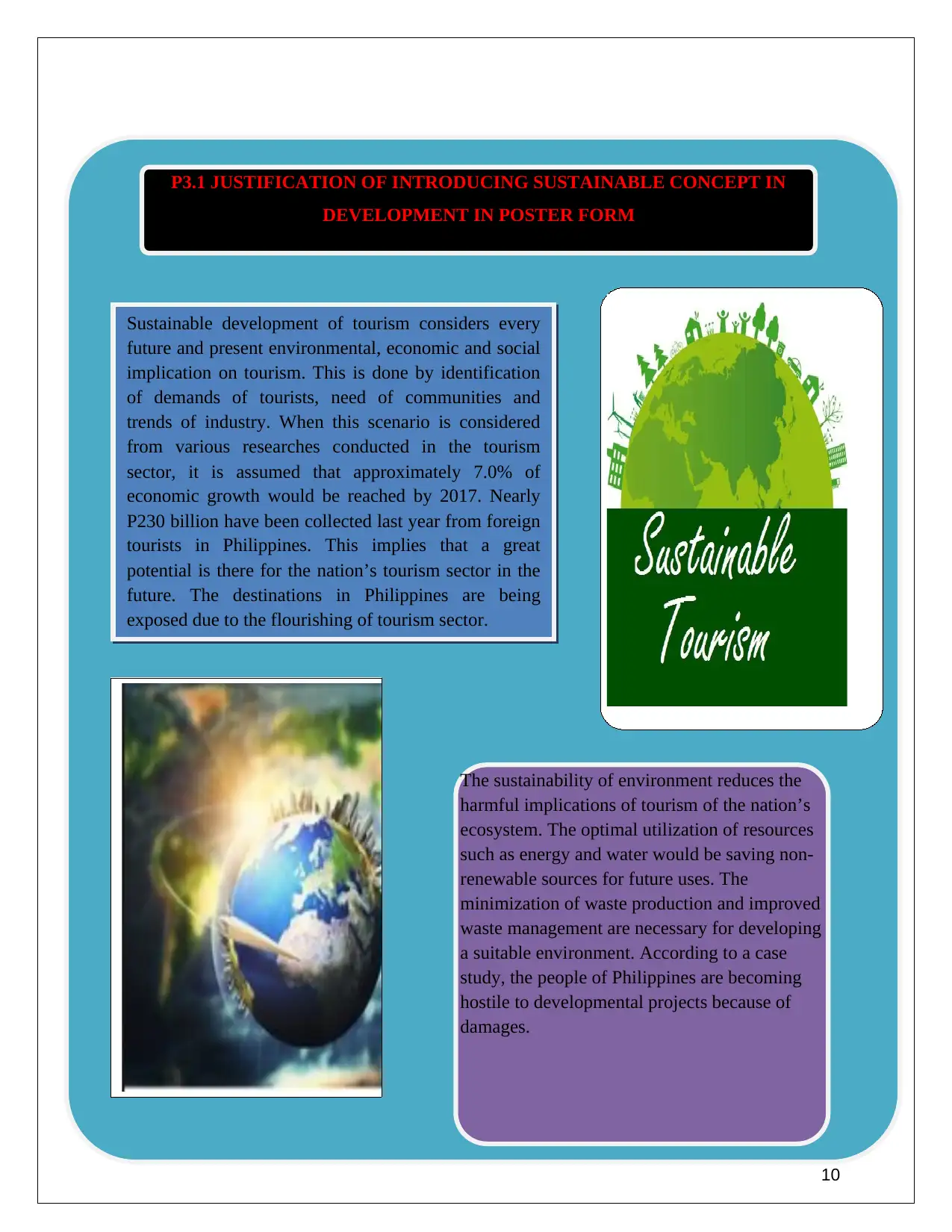
10
Sustainable development of tourism considers every
future and present environmental, economic and social
implication on tourism. This is done by identification
of demands of tourists, need of communities and
trends of industry. When this scenario is considered
from various researches conducted in the tourism
sector, it is assumed that approximately 7.0% of
economic growth would be reached by 2017. Nearly
P230 billion have been collected last year from foreign
tourists in Philippines. This implies that a great
potential is there for the nation’s tourism sector in the
future. The destinations in Philippines are being
exposed due to the flourishing of tourism sector.
The sustainability of environment reduces the
harmful implications of tourism of the nation’s
ecosystem. The optimal utilization of resources
such as energy and water would be saving non-
renewable sources for future uses. The
minimization of waste production and improved
waste management are necessary for developing
a suitable environment. According to a case
study, the people of Philippines are becoming
hostile to developmental projects because of
damages.
P3.1 JUSTIFICATION OF INTRODUCING SUSTAINABLE CONCEPT IN
DEVELOPMENT IN POSTER FORM
Sustainable development of tourism considers every
future and present environmental, economic and social
implication on tourism. This is done by identification
of demands of tourists, need of communities and
trends of industry. When this scenario is considered
from various researches conducted in the tourism
sector, it is assumed that approximately 7.0% of
economic growth would be reached by 2017. Nearly
P230 billion have been collected last year from foreign
tourists in Philippines. This implies that a great
potential is there for the nation’s tourism sector in the
future. The destinations in Philippines are being
exposed due to the flourishing of tourism sector.
The sustainability of environment reduces the
harmful implications of tourism of the nation’s
ecosystem. The optimal utilization of resources
such as energy and water would be saving non-
renewable sources for future uses. The
minimization of waste production and improved
waste management are necessary for developing
a suitable environment. According to a case
study, the people of Philippines are becoming
hostile to developmental projects because of
damages.
P3.1 JUSTIFICATION OF INTRODUCING SUSTAINABLE CONCEPT IN
DEVELOPMENT IN POSTER FORM
Paraphrase This Document
Need a fresh take? Get an instant paraphrase of this document with our AI Paraphraser
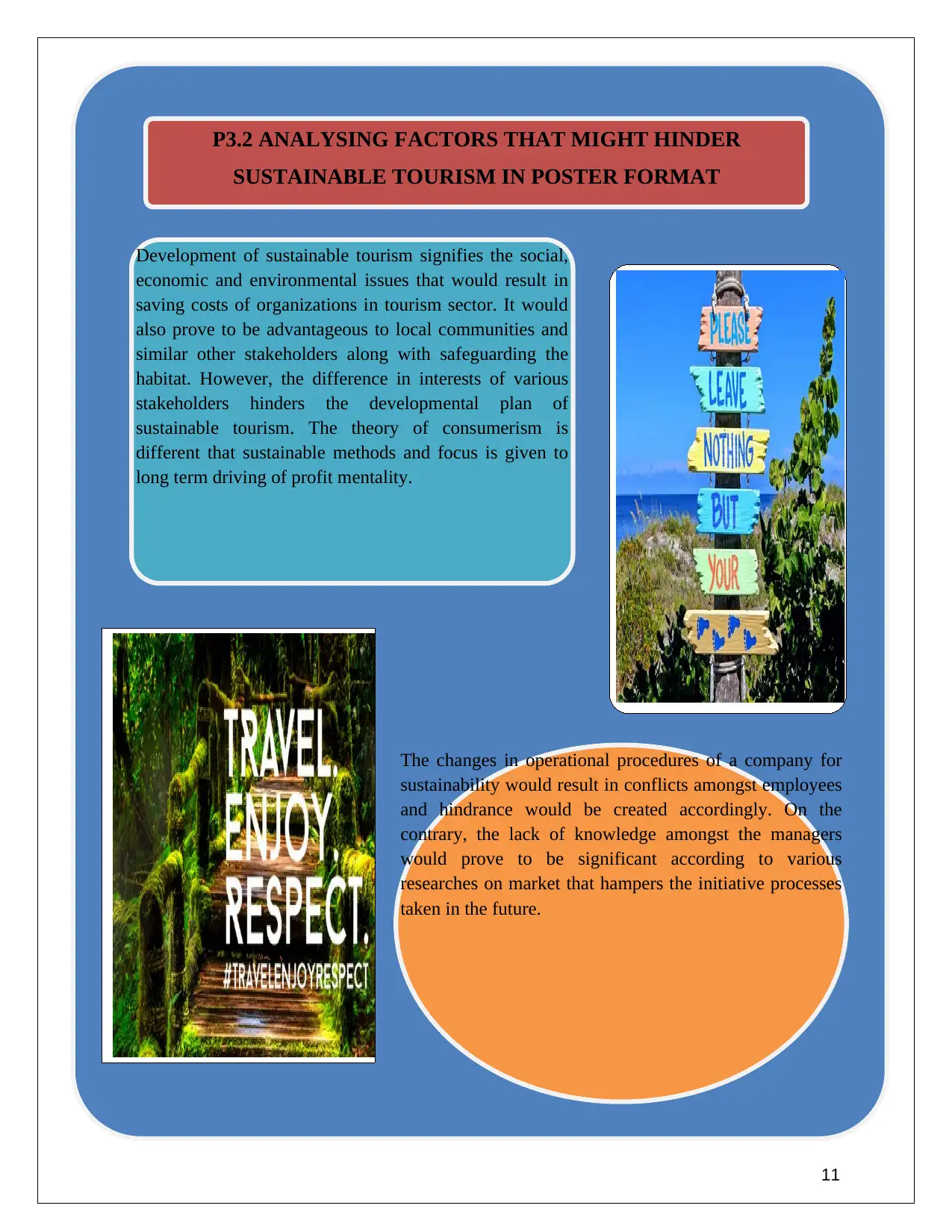
11
P3.2 ANALYSING FACTORS THAT MIGHT HINDER
SUSTAINABLE TOURISM IN POSTER FORMAT
Development of sustainable tourism signifies the social,
economic and environmental issues that would result in
saving costs of organizations in tourism sector. It would
also prove to be advantageous to local communities and
similar other stakeholders along with safeguarding the
habitat. However, the difference in interests of various
stakeholders hinders the developmental plan of
sustainable tourism. The theory of consumerism is
different that sustainable methods and focus is given to
long term driving of profit mentality.
The changes in operational procedures of a company for
sustainability would result in conflicts amongst employees
and hindrance would be created accordingly. On the
contrary, the lack of knowledge amongst the managers
would prove to be significant according to various
researches on market that hampers the initiative processes
taken in the future.
P3.2 ANALYSING FACTORS THAT MIGHT HINDER
SUSTAINABLE TOURISM IN POSTER FORMAT
Development of sustainable tourism signifies the social,
economic and environmental issues that would result in
saving costs of organizations in tourism sector. It would
also prove to be advantageous to local communities and
similar other stakeholders along with safeguarding the
habitat. However, the difference in interests of various
stakeholders hinders the developmental plan of
sustainable tourism. The theory of consumerism is
different that sustainable methods and focus is given to
long term driving of profit mentality.
The changes in operational procedures of a company for
sustainability would result in conflicts amongst employees
and hindrance would be created accordingly. On the
contrary, the lack of knowledge amongst the managers
would prove to be significant according to various
researches on market that hampers the initiative processes
taken in the future.
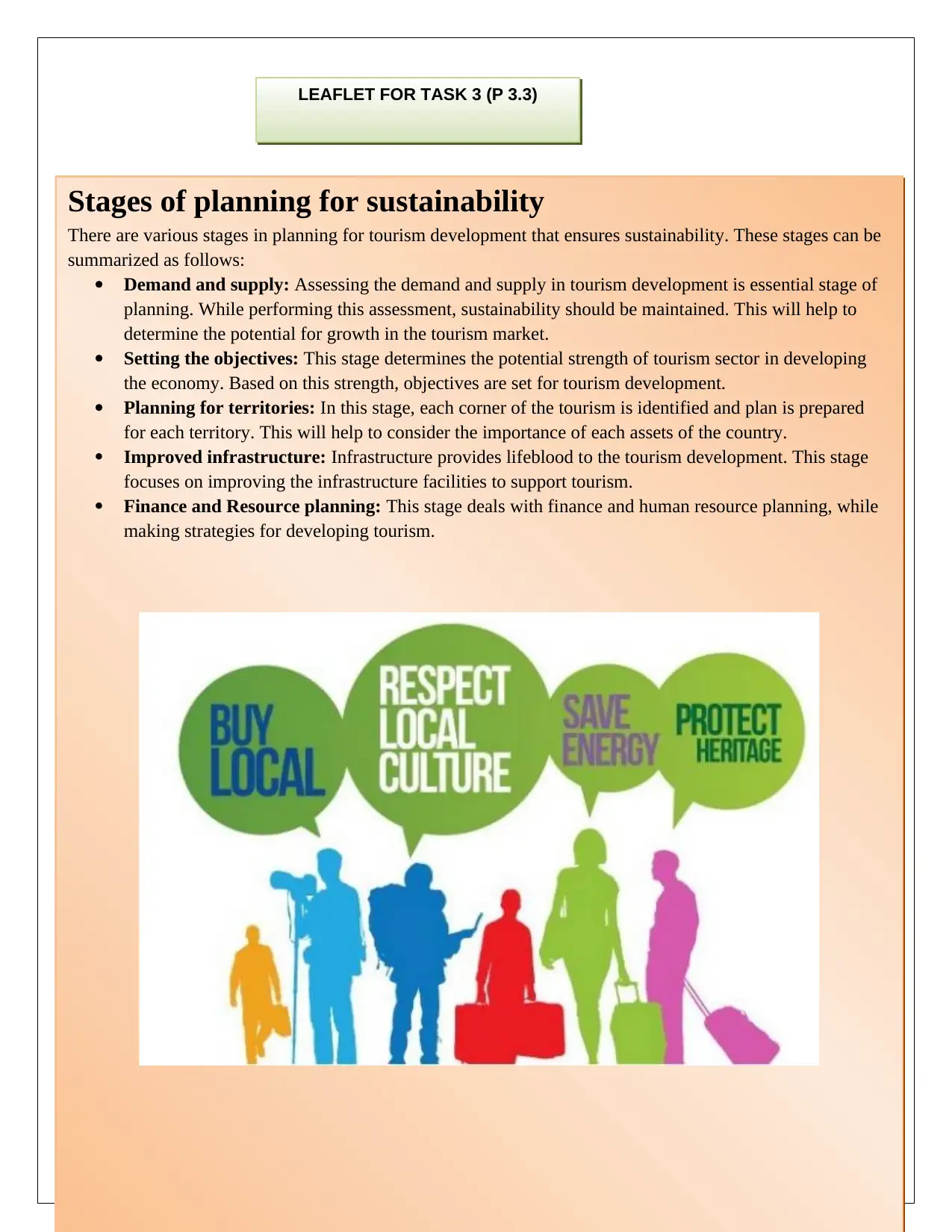
12
LEAFLET FOR TASK 3 (P 3.3)
Stages of planning for sustainability
There are various stages in planning for tourism development that ensures sustainability. These stages can be
summarized as follows:
Demand and supply: Assessing the demand and supply in tourism development is essential stage of
planning. While performing this assessment, sustainability should be maintained. This will help to
determine the potential for growth in the tourism market.
Setting the objectives: This stage determines the potential strength of tourism sector in developing
the economy. Based on this strength, objectives are set for tourism development.
Planning for territories: In this stage, each corner of the tourism is identified and plan is prepared
for each territory. This will help to consider the importance of each assets of the country.
Improved infrastructure: Infrastructure provides lifeblood to the tourism development. This stage
focuses on improving the infrastructure facilities to support tourism.
Finance and Resource planning: This stage deals with finance and human resource planning, while
making strategies for developing tourism.
LEAFLET FOR TASK 3 (P 3.3)
Stages of planning for sustainability
There are various stages in planning for tourism development that ensures sustainability. These stages can be
summarized as follows:
Demand and supply: Assessing the demand and supply in tourism development is essential stage of
planning. While performing this assessment, sustainability should be maintained. This will help to
determine the potential for growth in the tourism market.
Setting the objectives: This stage determines the potential strength of tourism sector in developing
the economy. Based on this strength, objectives are set for tourism development.
Planning for territories: In this stage, each corner of the tourism is identified and plan is prepared
for each territory. This will help to consider the importance of each assets of the country.
Improved infrastructure: Infrastructure provides lifeblood to the tourism development. This stage
focuses on improving the infrastructure facilities to support tourism.
Finance and Resource planning: This stage deals with finance and human resource planning, while
making strategies for developing tourism.
⊘ This is a preview!⊘
Do you want full access?
Subscribe today to unlock all pages.

Trusted by 1+ million students worldwide
1 out of 21
Related Documents
Your All-in-One AI-Powered Toolkit for Academic Success.
+13062052269
info@desklib.com
Available 24*7 on WhatsApp / Email
![[object Object]](/_next/static/media/star-bottom.7253800d.svg)
Unlock your academic potential
Copyright © 2020–2025 A2Z Services. All Rights Reserved. Developed and managed by ZUCOL.





